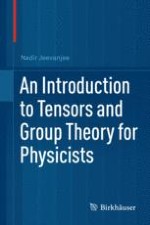2011 | OriginalPaper | Buchkapitel
3. Tensors
verfasst von : Nadir Jeevanjee
Erschienen in: An Introduction to Tensors and Group Theory for Physicists
Verlag: Birkhäuser Boston
Aktivieren Sie unsere intelligente Suche, um passende Fachinhalte oder Patente zu finden.
Wählen Sie Textabschnitte aus um mit Künstlicher Intelligenz passenden Patente zu finden. powered by
Markieren Sie Textabschnitte, um KI-gestützt weitere passende Inhalte zu finden. powered by

